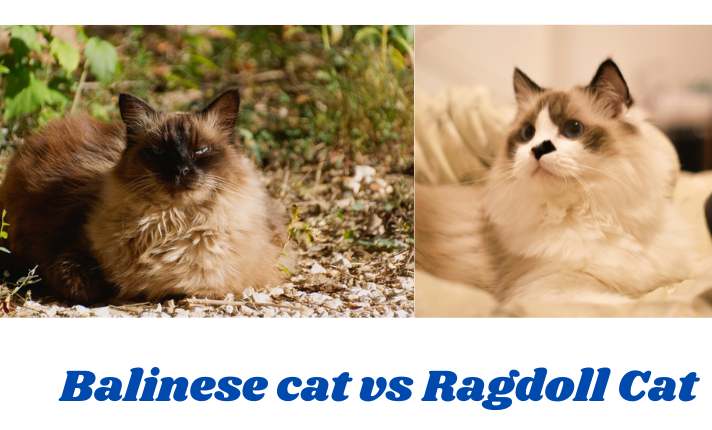Are you considering welcoming a new feline friend into your home? Two breeds that often catch the eye of cat lovers are the elegant Balinese and the affectionate Ragdoll. While both breeds make wonderful companions, they each have unique characteristics that may make one a better fit for your lifestyle than the other.
In this post, we’ll dive into the key differences between Balinese and Ragdoll cats to help you decide which of these captivating kitties could be your purr-fect match.
Here is a concise comparison of the key differences between Balinese and Ragdoll cats in table format:
| Characteristic | Balinese | Ragdoll |
|---|---|---|
| Size | Small to medium, 8-12 lbs | Large, 10-20 lbs |
| Body Type | Slender, long, muscular | Sturdy, heavy, muscular |
| Coat Length | Medium-long, silky | Long, plush |
| Coat Colors | Seal, blue, chocolate, lilac points | Seal, blue, chocolate, lilac, red, cream points and patterns |
| Eye Color | Blue, sometimes violet | Blue |
| Personality | Active, playful, talkative, more independent | Relaxed, gentle, cuddly, more human-dependent |
| Grooming Needs | Moderate, weekly brushing | Moderate, brush 2+ times per week |
| Intelligence | Exceptionally high | Average |
| Origin | United States | United States |
| Lifespan | 8-13 years | 12-15 years |
What’s Key Characteristics That Distinguish a Balinese cat From a Ragdoll?
Balinese and Ragdoll cats are both beloved breeds known for their affectionate nature and striking appearance, but they have several distinct characteristics that set them apart.
Let’s take a closer look at the key differences between these two felines.
1. Size and Body Type:
Balinese cats are a medium-sized breed. Ragdoll typically weigh 8-12 pounds. They stand around 8-11 inches tall, with a slender, elegant physique and fine bone structure giving them a delicate, graceful appearance.
In contrast, Ragdolls are considered one of the largest domestic cat breeds. They are true “gentle giants,” with Ragdoll weighing a substantial 15-20 pounds and some even exceeding 20 pounds. . Ragdolls have a large, muscular build with broad chests and can reach 9-13 inches in height and up to 40 inches in length from head to tail tip.
Their size and heavy bone structure give them a powerful, sturdy presence compared to the more moderate proportions of Balinese cats.

2. Visuals
Eyes:
Both Balinese and Ragdoll cats are known for their striking blue eyes. Balinese cats have almond-shaped eyes that are a brilliant, clear sapphire blue. More intense shades of blue are favored in cat shows.
Ragdoll cats also have captivating blue eyes. Their eyes are large, round and deep blue in color. All purebred Ragdolls have blue eyes, and if a Ragdoll has shades of green or yellow in their eyes, they are likely a mix and not purebred
Coat and Color:
Balinese cats have a long, silky single coat in traditional Siamese point colors like seal, chocolate, blue, and lilac. Their bodies are lighter shades with darker points on the face, ears, legs, and tail.
Ragdolls have a semi-long, dense, plush coat that comes in a wider variety of solid colors and patterns beyond just points. Common Ragdoll colors include seal, blue, chocolate, lilac, red, cream, and variations like lynx and tortoiseshell. Their coats can also have mitted, bicolor, and colorpoint patterns.
3. Balinese vs Ragdoll Cat: Personality and Temperament
Balinese and Ragdoll cats share some similarities in their affectionate, sociable personalities and love for human companionship, but they also have distinct differences.
Balinese cat
Balinese cats are more active, playful, and talkative, requiring mental stimulation and interactive playtime to keep them entertained. They are intelligent, curious, and enjoy following their owners around, engaging in conversation. While friendly with everyone, they crave attention and do not like being left alone for long periods.
Ragdoll cat
On the other hand, Ragdoll cats are known for their calm, relaxed, and even-tempered nature. They are sweet, gentle giants who go limp when held, giving them their name. Ragdolls are less vocal than Balinese and have a dog-like personality, often following owners around and enjoying being part of family activities. They get along exceptionally well with children and other pets due to their patient, tolerant personality.
While both breeds make loving companions, the Balinese is more energetic and demanding of attention, while the Ragdoll has a more laid-back, tranquil disposition

4. Health & Care:
Balinese cats are generally healthy but can be prone to certain conditions like progressive retinal atrophy (PRA) which can lead to blindness, mediastinal lymphoma (cancer), systemic amyloidosis affecting organs like the liver and kidneys, asthma, and congenital heart defects.
Their long silky coat requires weekly brushing to prevent matting and tangles. They are active and intelligent cats that need plenty of mental stimulation and playtime.
Ragdoll cats are a relatively healthy breed but can be at risk for hypertrophic cardiomyopathy (a heart condition), urinary tract issues like bladder stones, and obesity due to their laid-back nature.
Their semi-long coat needs brushing 1-2 times per week to remove loose hair and prevent hairballs. Ragdolls are large, docile cats that get along well with children and other pets but require daily playtime and interaction to prevent behavior issues from boredom.
5. Price:
Balinese cats typically cost between $800 to $1,500 from a reputable breeder, with show-quality kittens fetching prices up to $3,000. Common pedigree Balinese kittens from lesser-known breeders are usually priced around $800 to $1,500.
Ragdoll cats are more expensive, with prices ranging from $1,000 to $2,500 for a purebred kitten from a reputable breeder. Show-quality Ragdoll kittens from distinguished breeding lines can cost over $2,000. Pet quality Ragdolls may be available for around $400
6. Balinese vs ragdoll cat: Dependence on Humans
Balinese cats love being around people and enjoy their company, but they are not overly dependent on humans. They can be perfectly content on their own as long as they are provided with enough toys and scratching posts to keep them entertained. Balinese cats make ideal pets for owners who don’t have much free time to spend with their cats.
In contrast to Balinese cats, Ragdoll cats are incredibly dependent on their human owners. They were bred to be affectionate and loving companions, and they thrive on human interaction. Ragdolls are meant to be around humans; they would even get stressed or depressed if they feel lonely or neglected.
Therefore, Ragdoll cats are best suited for owners who can spend a significant amount of time with them and give them the attention they crave.

Conclusion
Choosing between a Balinese and a Ragdoll cat ultimately comes down to your lifestyle and personal preferences. If you’re looking for an active, curious companion who will keep you on your toes, the Balinese may be the breed for you. If you prefer a laid-back, cuddly lap cat who will be your constant shadow, the Ragdoll could be your ideal match.
Whichever breed you choose, you’ll be gaining a loving, loyal friend who will bring joy and companionship to your life for years to come. By providing your new feline family member with a healthy diet, regular vet care, plenty of enrichment, and lots of love, you’ll help them thrive and create a bond that will last a lifetime.
FAQs
Are Balinese and Ragdoll cats hypoallergenic?
While no cat is truly hypoallergenic, both Balinese and Ragdoll cats are considered to be less allergenic than some other breeds. However, if you have severe cat allergies, it’s best to spend time with the breed before bringing one home to see how you react.
Q: Can Balinese and Ragdoll cats live in apartments?
A: Absolutely. Their adaptable nature makes them well-suited for apartment living, provided they have enough space to play and explore.
Q: How often should I groom my Balinese or Ragdoll cat?
A: Regular grooming sessions, ranging from once a week to more frequently during shedding seasons, are recommended to keep their coats in top condition.
Q: Are these breeds suitable for families with children?
A: Yes, both the Balinese and Ragdoll cats are known for their gentle and patient demeanor, making them wonderful companions for children.

Hey guys, My name is Simon Smith. I’m from Canada and live near Victoria
I live with my sweet family and have 20+ Ragdolls of different types. I love them as my own children. My profession is as a hotel manager.
I love to keep Ragdolls and grow their breeder case. I have 7 years of experience.
I’m an expert in cat care. So, I’m here to provide you with new information about my cats daily. This is my personal blog website, so I request that you kindly visit our site daily.
If you’re a Ragdolls lover and you have any questions or confusion about cats, text me on the Contact Us page or Gmail.
Thank u
